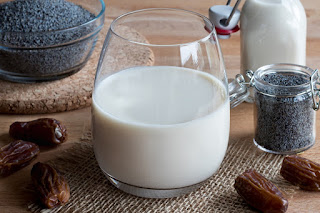The Lithuanians often have multiple dishes containing herring, while Latvians will also serve fish dishes to ensure you’ll have money in your wallet in the coming year. One source mentioned that
the larger the scales, the larger the wealth, however after reading Margaret’s
article “On the pitfalls of buying a carp for Christmas” I believe we might
skip the carp this year! Remember that Latvians place dried fish scales in their wallets on New Year’s Eve (to make
sure their wallets are full in the New Year), so save those scales after cleaning the fish...
It isn’t Kūčios
without the traditional Christmas Eve Cookies (Kūčiukai) and poppy seed milk
for Lithuanians, while Latvians insist that piparkūkas
be served, guaranteeing much love in the coming year. We featured June’s
kūčiukai on the series here, while Victoria discussed poppy seed milk in her
post High on Christmas. The 24 Days of a Baltic Christmas piparkūkas post can
be found here: Piparkūkas!
 |
| From article Piparkūkas! |
Another staple of the Kūčios
table is a cranberry Kissel drink.
Parallels could be drawn to the Latvian tradition of serving beets and carrots,
thought to ensure health in the New Year. However, cranberries are a popular
choice for Latvians as well, in the form of a sauce to pour over everything from meat dishes
to a buberts dessert. Tomorrow on 24
Days of a Baltic Christmas we’ll have the recipe for Cranberry Sparks, a
treat for the sweet tooth.
Catholicism is the dominant
religion in Lithuania (while in Latvians are predominantly Lutheran), which is
why sharing communion wafers during the Christmas Eve dinner is a common
practice in the southern Baltic country but not Estonia or Latvia. As Daiva wrote
in the article Kūčios, the Connection Between the Dead and the Living, a wafer is passed around the table and each family member
breaks and eats a piece, wishing the others a happy New Year. This year’s Baltic Imports 24
Days of a Baltic Christmas gift guide featured Oplatki Christmas wafers.
 |
| From article Medus torte |
Latvians believe it will bring
good fortune to have something round on the holiday table, as this will bring
sunshine in the coming year. The medus kūka (honey cake) is one option – it symbolizes the sun (recipe here). Grey peas are
another seasonal favorite; see the post Pelēkie zirņi and bacon for more on this. If
all the grey peas are eaten, then there will be no tears in the New Year...
 |
| Photo credit: Zilgma |
In my opinion (and probably
that of many a Latvian), Christmas wouldn’t be the same without pīrāgi (see 24 Days of a Baltic Christmas pīrāgi recipe!). Others
might argue the same of sauerkraut, which is a favorite on the Lithuanian table
as well (see post Sauerkraut, Two Ways!). Mushrooms, porridge, biscuits, nuts, dried fruit, and apples are
common in both countries. See the
 |
| From article High on Christmas |
One major difference is that the Lithuanian table was traditionally meat-free. On the other hand, Latvians didn't shy away from the cold cuts and pork dishes; a pig's head was a common winter solstice dinner!
 |
| Photo credit: Visi svētki vienuviet |
As for the remaining dishes, I
think many Latvians and Lithuanians would gladly share a table, potato salad
and meat in aspic being popular choices. (Andrējs contributed a Beginner's Guide to Galerts to the series last year...) Traditionally Latvian Christmas offerings can also include pork roast with oven baked potatoes, salmon, turnips and
beets. This Estonian Rosolje á la Polli Talu beet salad from Marika Blossfeldt could be on any Baltic holiday table!
Over the decades new dishes and
flavors have worked their way onto our holiday tables, but the passion for
delicious dishes and a richly-laid Kūčios
and Ziemassvētki table remains. The table set for a feast brings blessings and
fertility for the coming year, the rich foods symbolic of a year full of love,
wisdom and prosperity!
 |
| Photo credit: Lithuanian Home Cooking |
Whether you set the table with
nine or twelve dishes; whether you’re drinking poppy milk or buttermilk;
whether you are eating herring or carp… may your holiday table be rich not only
in the foods upon in but also the company around it!
***
For more on the traditional Kūčios table, please read Daiva Venckus's contribution to the series, "Kucios, the Connection Between the Dead and the Living." Another invaluable resource is her post "Lithuanian Pre-Christian Rituals and Superstitions in Today's Catholic Celebration." You may also be interested to read Barbara Tedrow's article, "Kūčios, the Longest Night."

No comments:
Post a Comment